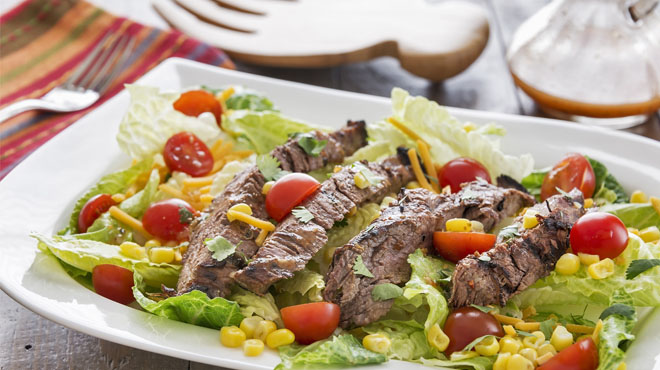
It’s summer, and people tend to eat out more regularly and attend events and festivities more frequently because of the warmer weather. In fact, according to some studies, almost half of customers dine out more frequently during the summer, frequently once a week.
Use restraint when eating.
It’s not necessary to give up all of your favorite meals to eat healthily, but the opposite is also true. Consider moderation and limit your intake of a few unhealthy foods to one serving, a few times per week, if you absolutely must consume them.
Create a balanced plate.
Make a nutritious platter whether you are eating at the cabin or at a graduation party. Vegetables, fruits, protein, and whole grains should all be in balance in your meal. Follow the Department of Agriculture’s recommendations for portion size and proportion, which state that you should fill half of your plate with fruits and vegetables and the other half with grains, protein, and dairy.
Read the labels.
Make sure to carefully examine the nutritional information on the menu or the nutrition facts label on food packaging, noting how many calories there are in each dish. A healthy adult should consume 500–700 calories every meal on average. Typically, breakfast contains fewer calories.
Shop and eat wisely.
Keep in mind the above-mentioned plate recommendations even when dining out. French fries aren’t thought to be nutritious, even though they are legally a vegetable. For fresh, low-calorie produce, browse the outside of the grocery store and go to your neighborhood farmer’s market.
Avoid sodium and reduce fat.
Pick lean, unprocessed meats to grill. Additionally, pick unsaturated fats and use less sodium when cooking. Try different herbs, spices, and vinegar combinations to create flavor.
Avoid fad diets at all costs.
Numerous diets make results-seeking claims that seem too good to be true, and they probably are. Before considering a fad diet, gather information, conduct research, or see a dietician.
Pick wise snacks.
All those afternoon cookies, late sweets, and morning pastries add up. When looking for a snack, pick fruit, low-fat yogurt, whole-grain foods, or veggies and dip. Fruit that is currently in season can make a delicious snack.
Drink plenty of water.
Even while it’s crucial to stay hydrated all year round, summer activities may cause more water to be lost through perspiration and evaporation. Be mindful of your drinking habits and stay hydrated. Make sure to select zero-calorie or low-calorie beverages because the calories in them can soon pile up. And despite the wide variety of beverages available, drinking plain or fruit-infused water is still one of the best and healthiest methods to hydrate your body.
Select lean meats.
Leaner meats should be chosen over the standard meal. Skinless chicken breasts and ground turkey are healthier meat substitutes. A healthy diet should contain fish regularly. For a low-calorie, high-protein lunch or dinner, grill salmon, tuna, lobster, steamer clams, and calamari. The best time of year to purchase the local grocer’s freshest catch of fish is during the summer. Instead, use whole wheat buns, lean meats, and delectable toppings like pineapple, wasabi, guacamole, and low-fat or fat-free feta cheese to create a healthy burger without compromising taste.
Benefit from Fresh Produce
Since food is at its best in the summer, now is the ideal time to revel in the best of nature by consuming the most recent fruits and vegetables.
- Tomatoes: You can get up to 40% of your required daily dose of vitamin C and 20% of your recommended daily intake of vitamin A by slicing one cup of raw tomatoes for your lunch salad.
- Avocados frequently appear in salads, dressings, and on top of hamburgers, so it’s a good thing they’re packed with fiber, antioxidants that protect cells, vitamins B5, B6, C, and K, folate, and potassium.
- Greens: During the spring and summer, beet greens, dandelion greens, spinach, lettuce, and Swiss chard are all in season. These greens are rich in fiber, vitamins B and C, iron, protein, and antioxidants that protect and repair cells. They also contain protein and iron. They not only make a fantastic salad, but you can also mash them up with some fresh fruit to make a green smoothie.
- Bell peppers offer color to a snack, salad, or meal, but this crunchy fruit has more going for it than meets the eye. A diet rich in foods high in carotenoids has been linked to a lower risk of developing cardiovascular disease and age-related eye problems. Carotenoids are phytochemicals that give bell peppers their vibrant colors.
Fruits: Always choose the freshest, highest-quality fruits while shopping.
- Berries: While each delicious variety of berries has its distinct nutritional qualities and practical advantages, all berries are abundant in antioxidants, fiber, and vitamin C, so boost your diet by eating the entire berry patch!
- Enjoy this delightful fruit all summer long since it boasts the greatest percentage of lycopene of any fresh fruit or vegetable.
